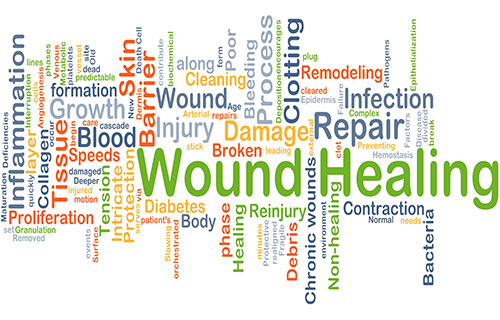מחקרים אחרונים פיתחו חבישות פצעים חדשות אשר מאיצות את הריפוי ומשפרות את התחדשות הרקמות בפצעים.
מדענים discovered a very important aspect of wound healing in the late 1970s when the understanding of this process was at a very early stage. It was seen that any wounds which were incurred in a baby before the seventh month of הֵרָיוֹן left no scars and there is fast scar less healing in early development of foetuses. This led the researchers to try and recreate or replicate these unique properties of the foetal skin which could be the used for regenerative medicine. The foetal skin is known to have very high levels of a חלבון called fibronectin. This protein fibronectin generally assembles into an extracellular matrix which in turn helps or rather promotes cell binding and adhesion. What is unique is that this property is very exclusive to foetal עור and is not found in adult cells. To elaborate this property further, fibronectin protein has two unique structures globular and fibrous. The globular structure i.e. the one spherical in shape is found in blood, while tissues in the body are fibrous. Fibronectins have always been seen as potential good candidates for ריפוי פצע אך ייצור פיברונקטינים סיביים נותר אתגר עד כה. במחקרים כפולים שפורסמו לאחרונה, חוקרים סיפקו תובנות לגבי שני סוגים שונים של ננו-פיבר dressings which use naturally-occurring proteins in plants and animals. These dressings are touted as very efficient in healing and re growing tissue in a wound. These current studies have pioneered the possibility of creating and developing nanofibers for wound healing. The whole idea of the authors was to creating dressings with the aim of developing therapeutics for wounds, especially those inflicted during war. The healing of such wounds is a painful process and is underserved by the wound therapeutics currently available.
במחקר הראשון שפורסם ב חומרים ביולוגיים, חוקרים מבית הספר להנדסה ומדעים יישומיים של הרווארד ג'ון א. פולסון (SEAS) וממכון Wyss להנדסה בהשראה ביולוגית ייצרו פיברונקטין סיבי על פלטפורמה בשם Rotary Jet-Spinning (RJS), שפותחה בבית1. הם תיארו א חבישת פצע באמצעות רקמת עובר. התהליך בן 2 השלבים היה פשוט, שבו תחילה תמיסת פולימר נוזלי (כאן, פיברונקטין כדורי מומס בממס) נטען למאגר ונדחף לתוך פתח זעיר על ידי כוח צנטריפוגלי בזמן שהמכונה הזו מסתובבת. כאשר תמיסה זו עוזבת את המאגר, הממס מתאדה והפולימרים מתמצקים. כוח צנטריפוגלי חזק זה פותח את הפיברונקטין הכדורי לסיבים קטנים ודקים (קוטר פחות ממיקרומטר אחד). סיבים אלה ניתן לאסוף תחבושת פצע או תחבושות. ניסויים בבעלי חיים הראו שפצעים שטופלו בחבישת פיברונקטין חדשה זו הראו שיקום של 84 אחוזים של רקמת העור תוך 20 יום בלבד, בעוד שהחבישות הרגילות שוחזרו 55.6 אחוזים. פעולת החבישה הזו הוסברה היטב. החבישה משתלבת בפצע ופועלת כמו פיגום מאלף אשר מאפשר לאחר מכן לתאי גזע שונים לבצע את ההתחדשות והסיוע הנדרשים לתהליך הריפוי של רקמות בפצע. החומר נספג בסופו של דבר בגוף. לפצעים המטופלים בחבישת פיברונקטין זו יש עובי אפידרמיס נורמלי מאוד וגם ארכיטקטורה עורית. אפילו השיער צמח מחדש באזור הפצע לאחר ההחלמה. זהו הישג גדול מכיוון שצמיחת שיער מחודשת נותרה אחד האתגרים המרכזיים בתחום ריפוי הפצעים. בהשוואה לתהליכים סטנדרטיים של התחדשות העור, הליך זה תיקן רקמות ביעילות וגם שיקם את זקיק השיער תוך שימוש ביכולת של חומר אחד בלבד. ברור שלגישה כזו יש יתרונות משמעותיים לתרגום המחקר לשימוש בפועל. חבישות פיברונקטין אלו יכולות להיות מתאימות ושימושיות עבור פצעים קטנים, במיוחד בפנים ובידיים שבהם חשוב למנוע צלקות.
במחקר השני שלהם שפורסם ב מתקדם בריאות חומרים, חוקרים פיתחו ננו-סיבי מבוסס סויה שמקדם ריפוי פצעים2. Soy protein contains,firstly, estrogen-like molecules (which are proven to accelerate wound healing) and secondly, bioactive molecules which contribute in building and supporting human cells in the body. These molecule types are routinely used in reproductive רפואה. Its very interesting that whenever the estrogen levels are higher in a woman’s body, their cuts or bruises heal faster. This is the reason pregnant women heal faster because they have such high estrogen. This is also the reason that an unborn baby inside the womb express scar-less wound healing because of the high levels of estrogen present. Researchers used the same RJS to spin ultra-thin soy fibres into wound dressings. These experiments also showed that soy and cellulose-based dressings on wound show 72 percent increased and improved healing, compared to only 21 percent in wounds without this soy protein dressing making them extremely promising. These dressings are inexpensive and thus optimally suited for large-scale usage, example for burn victims. Such cost-effective scaffolds are considered a revelation and have enormous potential for regenerative, especially for the militia, dressings under the umbrella of nanofiber technology.The Harvard Office of Technology Development has protected the intellectual property relating to these projects and is exploring commercialization opportunities.
***
{תוכל לקרוא את עבודת המחקר המקורית על ידי לחיצה על קישור ה-DOI המופיע להלן ברשימת המקורות המצוטטים}
מקור (ים)
1. Chantre CO et al. 2018. ננו-סיבי פיברונקטין בקנה מידה ייצור מקדמים סגירת פצעים ותיקון רקמות במודל של עכבר עורי. חומרים ביולוגיים. 166 (96). https://doi.org/10.1016/j.biomaterials.2018.03.006
2. Ahn S et al. 2018. פיגומי ננו-סיבי סויה/תאית המחקים מטריצה חוץ-תאית לעור לשיפור ריפוי פצעים. חומרים רפואיים מתקדמים. https://doi.org/10.1002/adhm.201701175






































